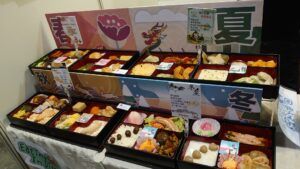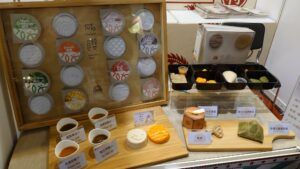Care Food
About Yee Hong Care Food Initiative
Yee Hong is committed to providing culturally appropriate services to seniors from different backgrounds to enhance their physical, emotional, social and spiritual wellbeing. In 2023, through a collaboration and knowledge exchange with The Hong Kong Council of Social Services, Yee Hong launched this social innovation – bringing “Care Food” culture into our community. We hope to benefit seniors, caregivers and other community members.
What is “Care Food”?
Care Food is “Caring, Love and Food.”
Eating is a basic human right however, some people cannot enjoy eating food due to swallowing difficulties resulting from health and age-related conditions. In the past, individuals with swallow difficulties could only eat pureed meals that often looked unappetizing and tasted bad because of a lack of resources and awareness that pureed meals can be made to be visually appealing and delicious.
Yee Hong’s Care Food initiative aims to share “Care Food” concepts and knowledge with the community to increase access to visually appealing and appetizing pureed foods. We also provide caregivers with various cooking techniques and methods to help their loved ones improve appetite and quality of life.
Benefits of Care Food
- More visually appealing
- Taste and texture consistent with regular food
- Less differentiation when served on table with caregivers; feeling “in group”
- Promotes food enjoyment and improves quality of life
- Homemade production allows caregivers to control ingredient choice and quality
- Improved appetite promotes better emotional outcomes and lowers risk of malnutrition




What is Dysphagia?
Dysphagia refers to the difficulty in swallowing and the inability to transport food safely and effectively from the mouth to the stomach and to obtain sufficient nutrition and water. Patients may have difficulty in eating or drinking, swallowing saliva, or taking medicines.
Dysphagia can be caused by different kinds of illnesses. In general, dysphagia is caused by damage to the muscles or nerves that control swallowing.
Common causes include:
- Stroke
- Parkinson’s disease
- Cognitive impairment
- Nasopharyngeal cancer
- Brain injury
- Acid reflux
- Side effects after surgery and treatment (such as muscle fibrosis, surgery that changes the structure of the swallowing duct, etc.)
The main symptoms of dysphagia occur when swallowing food, such as:
- Pain while swallowing
- Inability to swallow
- Food remains in the mouth, causing a bad breath in the mouth
- Food or drink coming out of mouth/ regurgitation
- A sensation of food getting stuck in esophagus or “stuck up” in throat when eating
- Takes a long time and a lot of effort to chew or swallow
- Coughing, wheezing, throat clearing or phlegm
- Hoarseness
Considering these uncomfortable symptoms, individuals with dysphagia often experience decreased appetite or may refuse to eat, which can lead to malnutrition, weight loss and dehydration, which seriously affects health.
If you notice these symptoms, you should contact and refer to your family doctor or primary health care provider as soon as possible.
What is IDDSI?
The International Dysphagia Diet Standardisation Initiative (IDDSI) was founded in 2013 with the goal of developing new international standardized terminology and definitions to describe texture modified foods and thickened liquids used for individuals with dysphagia of all ages, in all care settings, and all cultures.
The IDDSI Framework provides a common terminology to describe food textures and drink thickness. IDDSI tests are intended to confirm the flow or textural characteristics of a particular product at the time of testing. Testing should be done on foods and drinks under the intended serving conditions (especially temperature). The clinician has the responsibility to make recommendations for foods or drinks for a particular patient based on their comprehensive clinical assessment.
Visit this link for more detailed information.
Frequently Asked Questions
Can we cook “Care Food” at home?
Absolutely. We encourage caregivers to prepare Care Food at home, and considering cooking together with their families. You can cook “care food” with love and patience for your loved ones and modify “care food” recipes to personalize dishes to your preferences.
How can I judge the degree of softness and hardness of food that I need?
According to IDDSI standards, you can refer to different testing methods such as liquid flow, fork pressing, spoon tilting, etc. to learn to judge the degree of softness and hardness of food. For more information, please visit this link.
Is thickener a required ingredient to cook “Care Food”?
No, the most important thing about “care food” is that the cook should be aware of the degree of softness and hardness of the food, so that the user can enjoy it properly. Through different cooking methods (such as steaming, boiling etc.) and/or adding ingredients (such as corn flour, yam, potato, kanten etc.), you can change the viscosity or solidification degree of food, adding thickener is only one of the methods.
Is “Care Food” only suitable for seniors?
Seniors may experience swallowing difficulty due to aging, but anyone may develop dysphagia due to illness or as a result of medical treatments. As such, Care Food may benefit anyone experiencing obstacles in the functioning of the esophagus, oral cavity and other body that impacts the normal chewing process. Some people who have difficulties in chewing, such as tooth stripping, may also enjoy “Care Food” meals and drinks, so “Care Food” is not necessarily limited to seniors.
Resources Sharing
- Care Food, The Hong Kong Council of Social Service
- The International Dysphagia Diet Standardization Initiative
- Speech-Language & Audiology Canada
- Scope of Practice for Registered Dietitians Caring for Clients with Dysphagia in Ontario.
- Pureed foods for People with Dysphagia, UHN
- Dysphagia Cooking with Dr Weinberger, Deaconess Health
- 長者精緻軟餐, 明愛賽馬會照顧者資源及支援中心
- 「照護食軟餐食譜/軟餐食譜」食譜88篇, Cook1Cook
- Making of pureed meal, Hong Kong Ruttonjee & Tang Shiu Kin Hospital
- 【照護食標準指引】烹調示範 社聯照護食

